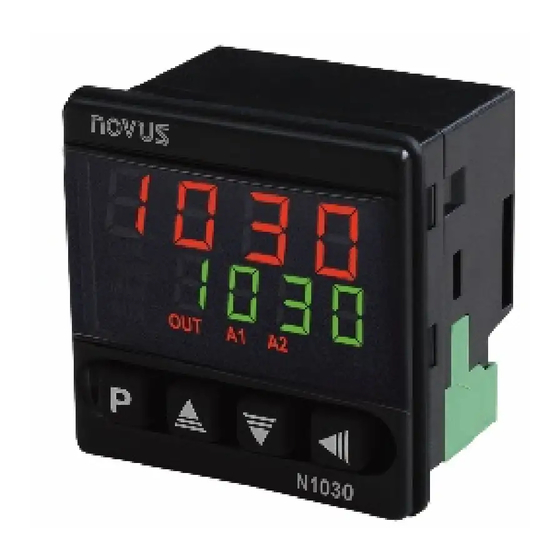
Table of Contents
Advertisement
Quick Links
N1030 Temperature Controller
INSTRUCTION MANUAL – V2.0x (*)
(*) The V2.0x version also covers V1.05 version controllers, except
for the points indicated in the text.
SAFETY ALERTS
The symbols below are used on the equipment and throughout this
document to draw the user's attention to important operational and
safety information.
CAUTION:
Read the manual thoroughly
before installing and operating
the equipment.
All safety related instructions that appear in the manual must be
observed to ensure personal safety and to prevent damage to either
the instrument or the system. If the instrument is used in a manner not
specified by the manufacturer, the protection provided by the
equipment may be impaired.
INSTALLATION / CONNECTIONS
The controller should be fixed to a panel, following the sequence of
steps below:
Make a cutout in the panel according to the Specifications.
•
Remove the controller fixing clip.
•
Insert the controller into the cutout from the front of the panel.
•
Replace the clip on the controller, pressing until it is well fixed.
•
INSTALLATION RECOMMENDATIONS
Input signal conductors should run through the plant separately
•
from output and supply conductors. If possible, in grounded
conduits.
The power supply for electronic instruments must come from a
•
network dedicated to the instrumentation.
The use of RC FILTERS (noise suppressors) in contactor coils,
•
solenoids, etc. is recommended.
In control applications, it is essential to consider what can
•
happen when any part of the system fails. The controller's
internal devices do not provide full protection.
ELECTRICAL CONNECTIONS
The figure below shows the connections on the back panel of the
controller:
Figure 1 –
Back panel connections
NOVUS AUTOMATION
CAUTION OR DANGER:
Electrical shock hazard
FEATURES
TEMPERATURE SENSOR (INPUT)
The temperature sensor or input type to be used by the controller is
defined during equipment configuration. Table 01 shows the
available options:
TYPE
CODE
Thermocouple J
Range: -110 to 950 ºC (-166 to 1742 ºF)
Tc j
Thermocouple K Tc k
Range: -150 to 1370 ºC (-238 to 2498 ºF)
Thermocouple T
Range: -160 to 400 ºC (-256 to 752 ºF)
Tc t
Pt100
Range: -200 to 850 ºC (-328 to 1562 ºF)
Pt
Table 1 – Input types
The input type should be the first parameter to be configured. Any
modifications on the input type will automatically change other
related parameters. When changing the sensor type, you should
check the overall condition of the configuration.
OUTPUTS
The controller has two outputs. You can configure these outputs to
operate as Control Output ((trl) or Alarm Output (a1).
OUT1:
-
N1030-PR: Output voltage pulse, 5 Vdc / 25 mA
N1030-RR: Output Relay SPST-NO
-
OUT2:
-
Output Relay SPST-NO
CONTROL OUTPUT ((TRL)
The process control output can operate in ON/OFF mode or in PID
mode.
To operate in ON/OFF mode, the value set in parameter PB must be
0.0.
With values other than zero in parameter PB, the controller operates
in PID mode. The values for the PID parameters can be set
automatically with the help of Auto Tune (ATvN).
ALARM OUTPUT (A1)
The controller has an alarm that can be directed to any of the outputs.
When enabled, you can configure the alarm to operate with one of the
functions described in Table 02:
Alarm off.
off
Alarm of absolute minimum
value. It triggers when the
value of measured PV is
lo
below the value defined for
alarm Setpoint (SPA1).
Alarm of absolute maximum
value. It triggers when the
value of measured PV is
ki
above the value defined for
alarm Setpoint (SPA1).
MEASUREMENT RANGE
PV
SPA1
PV
SPA1
1/5
Advertisement
Table of Contents

Summary of Contents for Novus N1030
- Page 1 Control Output ((trl) or Alarm Output (a1). The controller should be fixed to a panel, following the sequence of OUT1: steps below: N1030-PR: Output voltage pulse, 5 Vdc / 25 mA Make a cutout in the panel according to the Specifications. • N1030-RR: Output Relay SPST-NO Remove the controller fixing clip.
- Page 2 N1030 Controller Key: Key used to advance the successive parameters and Differential alarm. In this function, SPA1 represents parameter cycles. an error (difference) between CONTROL PV and SP. Increment key and Decrement key: Keys used to change parameter values. Back key: Key used to move back parameters during SP + SPA1 SP –...
- Page 3 N1030 Controller CALIBRATION CYCLE Derivative Time. Value of the term D of the control mode All input types are calibrated at the factory. If a recalibration is PID, in seconds. necessary, it must be performed by a specialized professional. If Adjustable between 0 and 250 seconds.
- Page 4 N1030 Controller PID PARAMETERS DEFINITION h) Apply a signal near the upper limit of the configured input measurement range to the input terminals. During auto-tuning, the process is controlled in ON/OFF mode at the i) In the ink( parameter, use the keys to make the programmed setpoint (SP).
- Page 5 Panel Cutout: ........ 45.5 x 45.5 mm (+0.5 -0.0 mm) N1030-PR model: ......... Approximate Weight: 60 g N1030-RR model: ......... Approximate Weight: 75 g POWER SUPPLY: ......100 to 240 Vac (±10 %), 50/60 Hz ..............48 to 240 Vdc (±10 %) Optional 24 V: ....











Need help?
Do you have a question about the N1030 and is the answer not in the manual?
Questions and answers